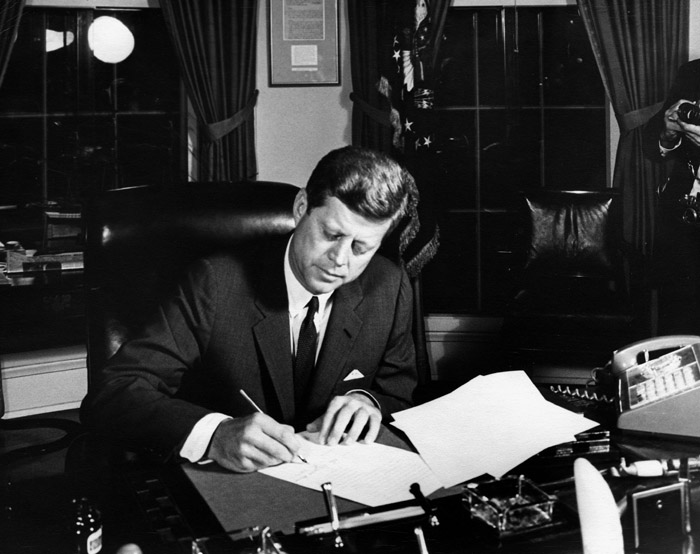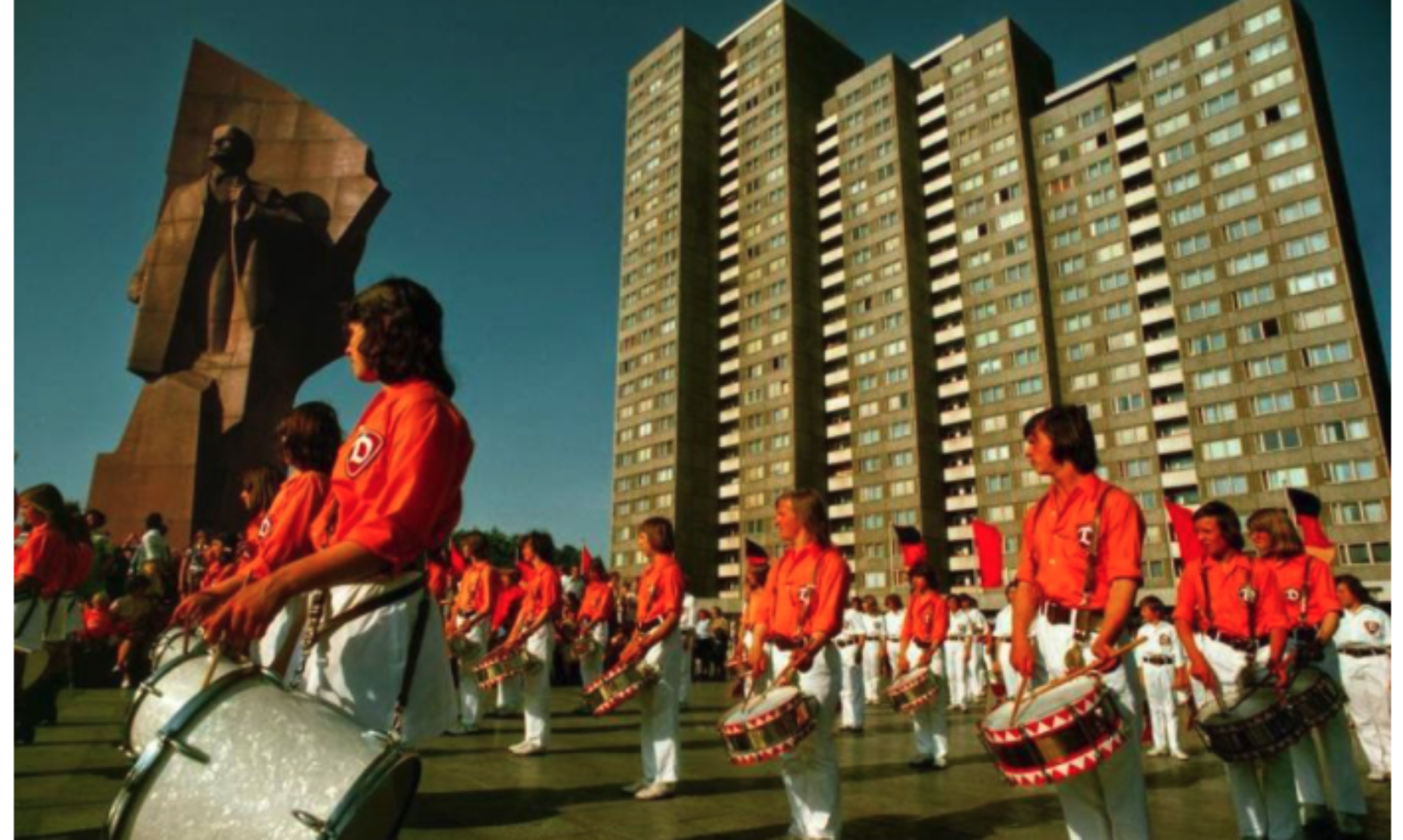Sigh of Relief Sweeps Across Globe as Nuclear Tensions Defuse
The Wash-Jeff Chronicle Monday, October 29th, 1962 Evening Edition

Americans can rest easy after the release of President Kennedy’s public statement yesterday. With cool level-headedness, he wrestled the Reds into backing out of Cuba. They have agreed to cease the importation of nuclear missile equipment and to dismantle existing offensive nuclear weapons on the island.2 There are plenty of elements that pose serious doubts about the general public’s safety as well as the technological supremacy of the United States. But we are not out of the woods yet. While the Russians have agreed to remove their offensive weapons, this agreement cannot be construed as a complete victory for the United States. The proximity of the Russian missiles, their swift deployment, and their denial of both to a global audience indicate the unpreparedness of the U.S. response and how little importance such a slim victory is on the global scale.
The nation first became aware of this existential crisis on October 22nd. In that day’s speech, President Kennedy made known unquestioningly clear to the Reds and U.S. citizens that “This Government, as promised, has maintained the closest surveillance of the Soviet Military buildup on the island of Cuba…Within the past week, unmistakable evidence has established the fact that a series of offensive missile sites is now in preparation on that imprisoned island.”3 With irrefutable evidence of Soviet movements, Kennedy sternly reassured that “upon receiving the first preliminary hard information of this nature last Tuesday morning at 9 a.m., I directed that our surveillance be stepped up…this Government feels obliged to report this new crisis to you in fullest detail.”4 Cuba has been the source of contentions and surveillance for quite some time for this administration. After the fiasco that was The Bay of Pigs invasion in 1961, Kennedy’s public approval has been tenuous and Fidel Castro’s ties with the USSR served as a reminder of that failed operation to depose communism. With the embarrassing failure of that operation to overthrow the relatively new leader, it was not hard to predict that Castro likely had a bone to pick with the United States. Considering the complex nature of these developments, it appears that the President sought the close advice of his cabinet and various policy advisors, including his brother Robert F. Kennedy, the current Attorney General of the United States.5
However, America could hardly expect such a sudden escalation of the Cold War, and the East-West arms race has rapidly unfolded before our very eyes. The Soviet movements were able to begin the process of deploying and erecting nuclear missiles in the U.S.’s backyard to the surprise of this current administration. In the clearest terms, their deployment of medium and intermediate-range ballistic missiles just ninety miles off the coast of Florida was an unquestionable act of escalation.6 Surely, it was not solely Soviet goodwill towards Cuba that inspired the placement of these warheads so close to the continental United States. Perhaps the Reds felt pressure to act out of fear of NATO activities in Europe, specifically the ever-increasing number of bases and missile launch sites in Turkey near the Soviet borders.7 These brazen Soviet actions give U.S. citizens quite some pause about the capabilities of the U.S. to prevent further actions. Perhaps these covert operations were their gamble to level the playing field, but the volatility of placing nukes in our backyard could not be lost to Khrushchev as a way to force our hands and see if the U.S. would react as the Soviets had when missiles were placed in Turkey.8
Khruschev’s displeasure of nuclear weapons far precedes the events of the past week. In September of 1959, he called for an end to the Cold War and the gradual disarmament between East and West.10 While this wish seemed promising, it also seems to have been just an alluring invention when compared to his policies in matters such as this Cuba crisis. Considering the relatively lengthy balance of power since the end of the Second World War, and the United States’ great capability of nuclear retaliation, it is hard to measure the threat of the missiles that were being installed in Cuba, though it was definitely carried out with the intention to cause alarm to both the American government and public. While the Soviets withdrew the missiles from Cuba, it makes one wonder as to if it were not them but the U.S. who blinked in this international game of nuclear chicken. After all, the Soviets have lived in the presence of short-range missile installations across continental Europe for some time with seemingly little outrage save for the Premier himself.11 Is the inability to live in such close proximity to such weapons in return some type of shortcoming of the U.S.? Of course, this question should not take away from the great relief of no longer living with the threat of nuclear war over our heads, but it is warranted when comparing the state of the nation as opposed to the Soviets. Surely, this is how the Soviet government will spin the story for the time being.
Looking back at the events of the past week, reports indicate that following his televised address on the 22nd President Kennedy initiated a new series of high altitude photographic reconnaissance missions by the US Air Force to capture evidence of the missile sites. These photographs would capture the Soviet bases, along with nearby soviet equipment and installations, for the world to see during a U.N. Security Council meeting. During this meeting on October 25th, U.S. Ambassador to the U.N. and two-time Democratic presidential nominee Adlai Stevenson II cornered Soviet Ambassador Valerian Zorin into implying that the Soviet Union had not in fact installed missiles in Cuba.12 Though Ambassador Zorin appeared to question the validity of Stevenson’s claims, the American delegation had the photographs to back up their allegations. These photos, which Stevenson promptly displayed, proved the presence of missiles in Cuba and undermined the Soviet Union’s attempts to suppress it
Such photos as these came at a cost, however, as on October 27th, USAF officer Major Rudolf Anderson, a U-2 pilot, was shot down by a Soviet surface-to-air missile (also known as a SAM) while gathering more photographs, catching the nation by surprise. 14 In addition to the death of Anderson, several reports also claimed that joint Cuban and Soviet anti-aircraft batteries had fired at numerous U.S. Navy F-8 Crusader aircraft as they took low-level photographs of the missile installations.15 The United States Air Force has yet to comment on these reports or confirm their credibility. If they are indeed true, it would mean that conventional military tactics had been used during this crisis and possibly brought us closer to nuclear annihilation than previously believed.
Regardless of how the crisis nearly escalated to irreversible levels, it leaves the U.S. and its allies in a state of limbo. What is next for Cuba? Will Khruschev pursue other efforts to assert Soviet military might across the West? It certainly seems possible in view of these recent events. While the Kennedy Administration undoubtedly has a laser-like focus on Europe for the time being, it would be quite rash for Khruschev to act immediately after this crisis was resolved, thus promising at least some time before another major event threatens to disturb the current balance of power between the two greatest superpowers. This of course depends on what occurred during negotiations between the administration and the Soviet diplomats, though it appears that Kennedy has made Khruschev blink first.16 Given the Premier’s firmness in international affairs so far, it is difficult to believe he would budge without either more plans in the works or gaining something in reply. Taking into account just how close we came to waking up in a very different world, perhaps a small sacrifice along the lines of the latter is a worthy price to preserve this Earth for future generations and prevent such a disaster as nuclear war. Avoiding war, in either case, is a clear victory for both sides, although the positive public appearance of the U.S. in the wake of this incident cannot be understated.
While we may take a breath for the time being, the storm is not yet over. The Soviet Union is still a powerful force to be reckoned with and likely wants to prove that power in order to entice other nations into welcoming their ways. There is also the possibility that they are attempting to lure the U.S. into a false sense of security while they make moves elsewhere that further endanger NATO allies and the safety of the West Berliners. With this in mind, it would be hard to view the recent developments as a victory for the United States unless the military maintains all of its current assets along the Iron Curtain, especially in pivotal border nations like Turkey.17 Whether or not this is the case we do not know for the time being. But, with things finally calming down, let’s enjoy things while they last before we once again return to our strict and unwavering vigilance against the Red menace.
End Notes
- “John F. Kennedy Signs Proclamation 3504” John F. Kennedy Presidential Library & Museum. October 28, 1962 – Cuban Missile Crisis – John F. Kennedy Presidential Library & Museum. Accessed March 14, 2021. https://microsites.jfklibrary.org/cmc/oct23/
- Brian Dooley. “The Cuban Missile Crisis–30 Years On.” History Today 42, no. 10 (October 1992): 7. http://search.ebscohost.com/login.aspx?direct=true&AuthType=shib&db=hlh&AN=9210190367&site=eds-live.
- Ted Sorensen. “JFK on the Cuban Missile Crisis – 1962.” Read by John Fitzgerald Kennedy. 1962; Washington D.C.: Associated Press. Oct 21, 2016. Youtube. 00:00:45-00:01:01 https://www.youtube.com/watch?v=u07rkwHTPLk
- Ibid., 00:01:11-00:01:37
- Cody Fuelling. “To the Brink: Turkish and Cuban Missiles during the Height of the Cold War.” International Social Science Review 93, no. 1 (July 2017): 6.
- Ibid., 6.
- Ibid., 4-5.
- Sherry Nay. “The Cuban Missile Crisis: The Soviet View.” Torch, Fall 2015, 30-31. http://search.ebscohost.com/login.aspx?direct=true&AuthType=shib&db=asn&AN=117015224&site=eds-live
- Sorensen., 00:00:00-00:18:49.
- Nikita Khruschev. “Speech by Nikita Khrushchev: WNYC: New York Public Radio, Podcasts, Live Streaming Radio, News.” WNYC. Sept 19, 1959. 00:16:22-00:18:15 https://www.wnyc.org/story/speech-by-nikita-khrushchev/
- Fuelling, 4.
- British Movietone. CUBA – ROCKET PHOTO’S SHOWN TO UNITED NATIONS – SOUND.YouTube. YouTube, 2015. 00:02:00- 00:03:04 https://www.youtube.com/watch?v=bBEowra3500.
- Ibid., 00:00:00- 00:03:04.
- William B. Ecker and Kenneth V. Jack. Blue Moon over Cuba: Aerial Reconnaissance during the Cuban Missile Crisis. London: Osprey Publishing, 2013. Chapter 10 paragraph 31 (ebook does not have page numbers)
- Ibid., Chapter 10 paragraph 29 (ebook does not have page numbers)
- Dooley, 7.
- Nay, 31.
Work Cited
British Movietone. CUBA – ROCKET PHOTO’S SHOWN TO UNITED NATIONS – SOUND.YouTube. YouTube, 2015. https://www.youtube.com/watch?v=bBEowra3500.
Dooley, Brian. “The Cuban Missile Crisis–30 Years On.” History Today 42, no. 10 (October 1992): 6-8. http://search.ebscohost.com/login.aspx?direct=true&AuthType=shib&db=hlh&AN=9210190367&site=eds-live.
Ecker, William B., and Kenneth V. Jack. Blue Moon over Cuba: Aerial Reconnaissance during the Cuban Missile Crisis. London: Osprey Publishing, 2013.
Fuelling, Cody. “To the Brink: Turkish and Cuban Missiles during the Height of the Cold War.” International Social Science Review 93, no. 1 (July 2017): 1–15. http://search.ebscohost.com/login.aspx?direct=true&AuthType=shib&db=bsu&AN=124988166&site=eds-live.
“John F. Kennedy’s Public Statement October 28th 1962” John F. Kennedy Presidential Library & Museum. October 28, 1962 – Cuban Missile Crisis – John F. Kennedy Presidential Library & Museum. Accessed March 14, 2021. https://microsites.jfklibrary.org/cmc/oct28/.
“John F. Kennedy Signs Proclamation 3504” John F. Kennedy Presidential Library & Museum. October 28, 1962 – Cuban Missile Crisis – John F. Kennedy Presidential Library & Museum. Accessed March 14, 2021. https://microsites.jfklibrary.org/cmc/oct23/
Khruschev, Nikita. “Speech by Nikita Khrushchev: WNYC: New York Public Radio, Podcasts, Live Streaming Radio, News.” WNYC. Sept 19, 1959. 00:00:00- 00:18:15 https://www.wnyc.org/story/speech-by-nikita-khrushchev/
Nay, Sherry. “The Cuban Missile Crisis: The Soviet View.” Torch, Fall 2015, 29–32. http://search.ebscohost.com/login.aspx?direct=true&AuthType=shib&db=asn&AN=117015224&site=eds-live.
Sorensen, Ted. JFK on the Cuban Missile Crisis – 1962. Read by John Fitzgerald Kennedy. 1962; Washington D.C.: Associated Press. Oct 21, 2016. Youtube. 00:00:00-00:18:49. https://www.youtube.com/watch?v=u07rkwHTPLk
